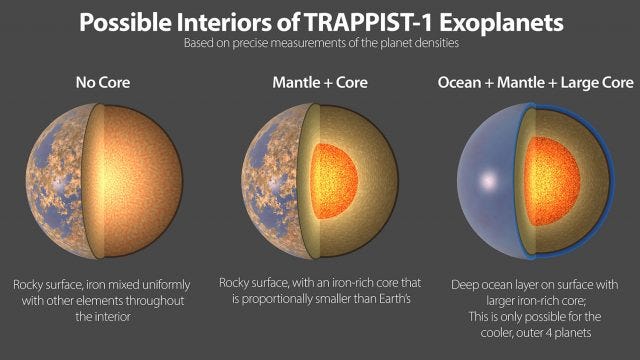Exploring the Remarkable Similarities of TRAPPIST-1's Seven Planets
Written on
Chapter 1: The Quest for Exoplanets
Recent advancements in both ground-based and space telescopes have significantly improved our ability to detect exoplanets. Rather than finding isolated planets, astronomers are now uncovering entire solar systems. Among these, TRAPPIST-1 has captured significant attention due to its ensemble of seven planets, which were identified in 2016 and 2017. A recent study has verified that these planets are all small and rocky, resembling Earth, and exhibit surprising similarities.
The TRAPPIST-1 system was initially detected using the TRAPPIST telescope located in Chile. At that time, scientists anticipated that all planets would be rocky, with several residing in the star's habitable zone. Being a red dwarf, TRAPPIST-1 means that these potentially habitable planets are in close proximity, with their solar years measured in Earth days. Remarkably, all seven exoplanets orbit closer to TRAPPIST-1 than Mercury does to our Sun.
The research team led by Erik Agol from the University of Washington estimated the masses of these planets by monitoring their transits across the star. By correlating this with orbital timing, they gained valuable insights into the mass and diameter of the exoplanets. Interestingly, the planets are found to be eight percent less dense than if they had a composition akin to Earth.
This density measurement falls within the expected range, yet planetary compositions can vary significantly. Never before have we encountered a solar system with such remarkable consistency. In our own solar system, gas giants like Jupiter exhibit much lower densities compared to Earth, and even among rocky planets, density varies widely—Mars, for instance, is about 70% as dense as Earth.

Section 1.1: The Mystery of Lower Density
The research team has proposed three potential explanations for the lower density observed in the TRAPPIST-1 planets, each suggesting different characteristics for these celestial bodies. One possibility is that their composition resembles that of Earth but contains less iron. If they possess iron cores similar to Earth, they would simply be slightly smaller.
Another theory posits that iron is uniformly distributed throughout the exoplanets alongside oxygen, resulting in planets akin to large spheres of rust lacking an iron core. A more intriguing hypothesis suggests that deep oceans might envelop the four outer planets, although this scenario is less likely due to the precise balance of water content required to maintain the observed density.
We may soon identify which of these hypotheses is accurate. The TRAPPIST-1 system has become a favored target for astronomers, given the abundance of planets to examine in one location. Moreover, its proximity—only 40 light-years away—makes it an excellent candidate for study using advanced instruments like the upcoming Webb Space Telescope, although traveling there with current technology would take hundreds of thousands of years.
The first video titled "TRAPPIST-1 and 7 Earth-Like Planets - 2017 NASA Discovery!" delves into the groundbreaking discoveries surrounding the TRAPPIST-1 system and its seven Earth-like planets.
The second video, "Homes Away From Home? Revisiting the Seven Planets of TRAPPIST-1," revisits these intriguing planets and their potential for habitability.